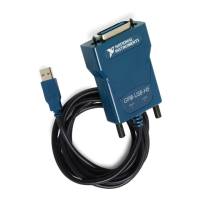Chapter 8 NI-488.2 Programming Techniques
NI-488.2 User Manual 8-20 ni.com
2. Conduct the parallel poll using PPoll, store the response, and check
the response for a certain value. In the following example, because
DIO5 is asserted by the device if
ist is 1, the program checks
bit 4 (hex 10) in the response to determine the value of
ist.
PPoll(0, &response);
/* If response has bit 4 (hex 10) set, the ist bit
of the device at that time is equal to 1. If
it does not appear, the ist bit is equal to 0.
Check the bit in the following statement. */
if (response & 0x10) {
printf("The ist equals 1.\n");
}
else {
printf("The ist equals 0.\n");
}
3. Unconfigure the device for parallel polling using PPollUnconfig, as
shown in the following example. In this example, the
NOADDR constant
must appear at the end of the array to signal the end of the address list.
If
NOADDR is the only value in the array, all devices receive the parallel
poll disable message.
AddressList[0] = 3;
AddressList[1] = NOADDR;
PPollUnconfig(0, AddressList);

